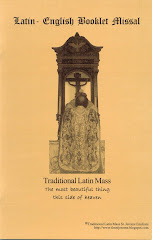The Institute of Christ the King Sovereign Priest addresses some misconceptions:
The Classical/Traditional Latin Mass is not a product of the 16th-century Council of Trent.
The history of the Traditional Latin Mass, whose latest version dates from 1962, traces back to the beginnings of Christianity. The Mass went through organic, gradual development throughout the centuries. The first written record of the Prayers of the Latin Mass is found in a 6th-century manuscript (Leonine Sacramentary). The Roman Latin Mass was codified and made universal in the 16th century by Pope St. Pius V because of the liturgical confusion then reigning. As this codification was part of the measures taken by the Council of Trent, the Traditional Latin Mass has often been called “Tridentine Mass.” After this, as before, small, incremental changes were made to the Missal (book containing texts and prayer for Mass) in the centuries following, the latest being made by Pope John XXIII in 1962. In 1969 Pope Paul VI promulgated a new Mass (Novus Ordo Missae) designed by an appointed committee, based on the Traditional Mass but with substantial changes to it, particularly in the Offertory prayers.
The Traditional Latin Mass was not changed or replaced by the Second Vatican Council (1962-65).
In fact, it was the Mass celebrated during the Council. A document produced by the Second Vatican Council (Sacrosanctum Concilium) outlined certain directives for changes to the Mass. Additional directives were given in post-conciliar documents. The new Mass (Novus Ordo) was crafted after the Council by a committee and promulgated in1969 by Pope Paul VI.
The priest facing the people was not a practice introduced by Second Vatican Council.
The orientation of the priest toward the East, with the people, symbolic of all facing God together toward the same direction, is millenary. It is the norm for the Traditional Latin Rite, and in this is shared by all the Eastern Rites of the Catholic Church as well as by the Orthodox Church.
The custom of the priest facing the people, instead of East with the people, was gradually introduced as an experimentation by some members of the priesthood in the 20th century. It became the unwritten practice in the Novus Ordo Mass, though there are no directives to do so in the documents issuing from the Second Vatican Council nor in the Missal of 1969. The first written mention in an official Church document of the possibility of a priest facing the people during Mass dates of the year 2000, in the General Instructions of the Roman Missal issued by the Vatican. (GIRM 299)
Mass in the vernacular (in English) was not introduced by the Second Vatican Council.
As stated above, the Novus Ordo Mass was not produced by the Second Vatican Council. In the Second Vatican Council document on the liturgy (Sacrosanctum Concilium), mention is made of the possibility of the Mass being translated to the vernacular. However, the Council also confirmed that the official language of the Catholic Church is Latin. Accordingly, the original language of the Novus Ordo Mass of 1969 is Latin, translations then being made from this original text.
http://www.institute-christ-king.org/ResourcesHome/Documents.htm
3 comments:
Is it possible for St. Jerome to do a Traditional Baptism??
Our family friend is interested of baptizing their son in the traditional way..
thanks,
nikko leyretana
TLM St. Jerome Jr. Altar Server
I left behind a "Book of Blessings" that includes the rite of baptism according to the usus antiquior. Please call Elaine at 842-5361 so she can make the necessary arrangements with Fr. Grato. If this pushes through, this will be a first for St. Jerome.
We have done this 3 times already in PLDM sikatuna.
Post a Comment